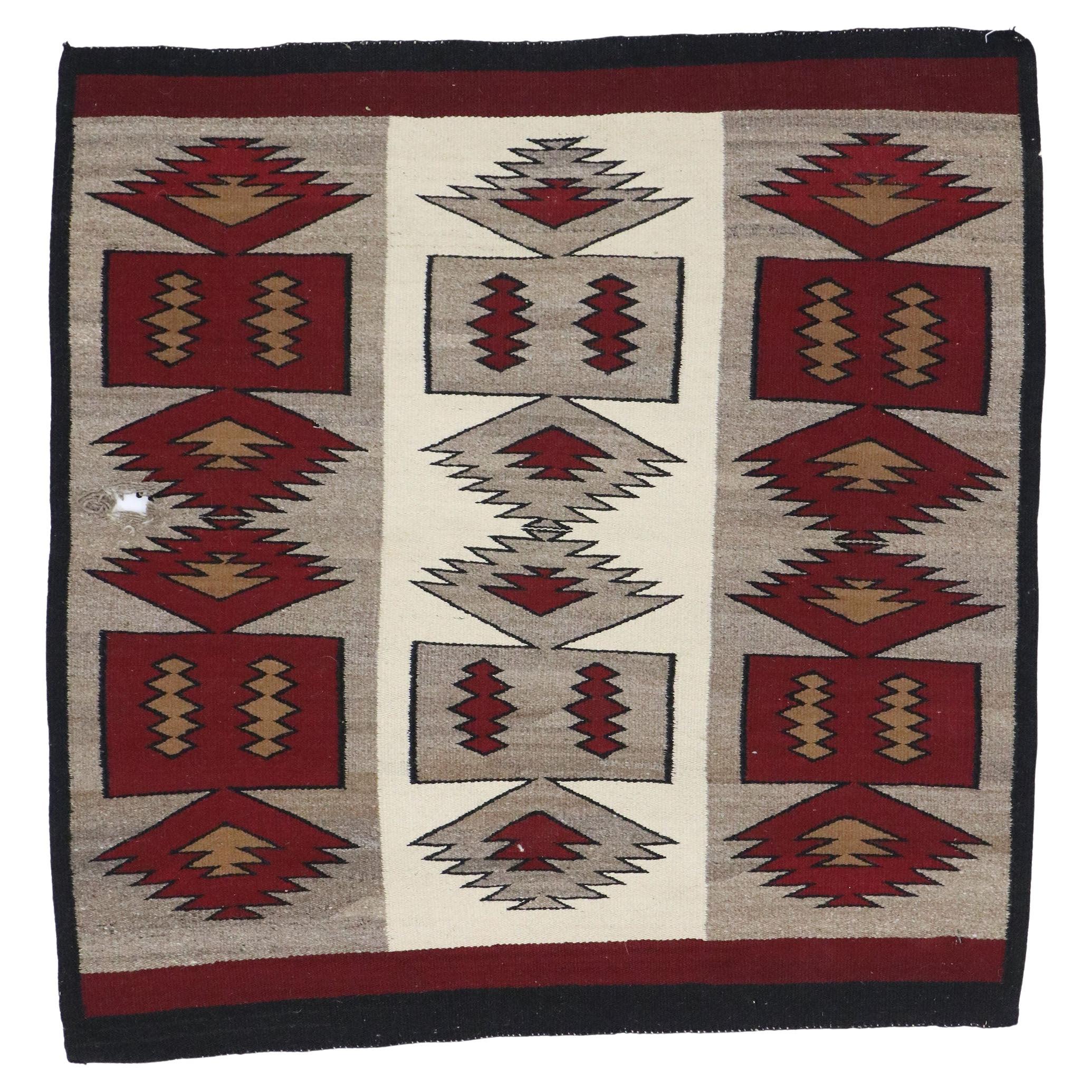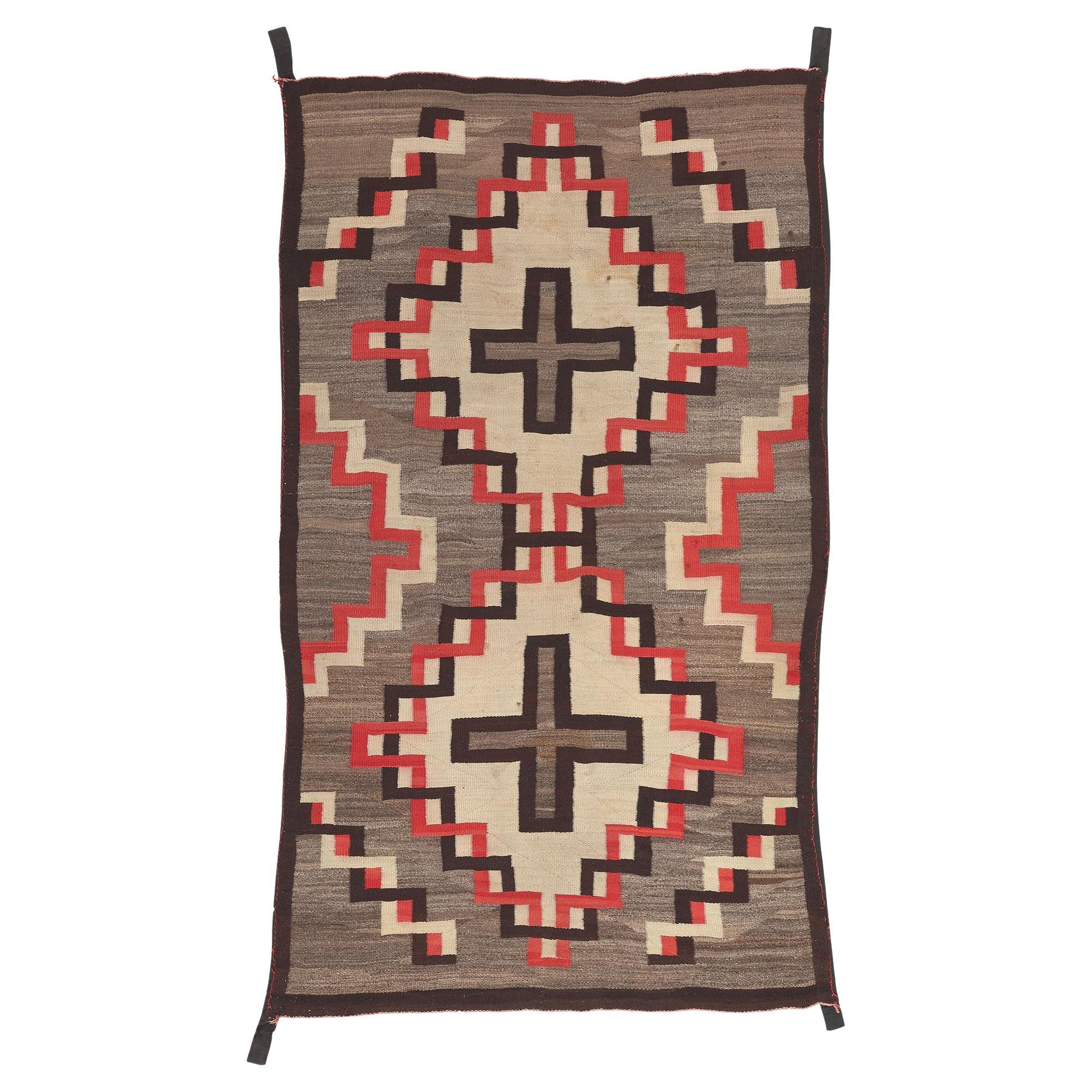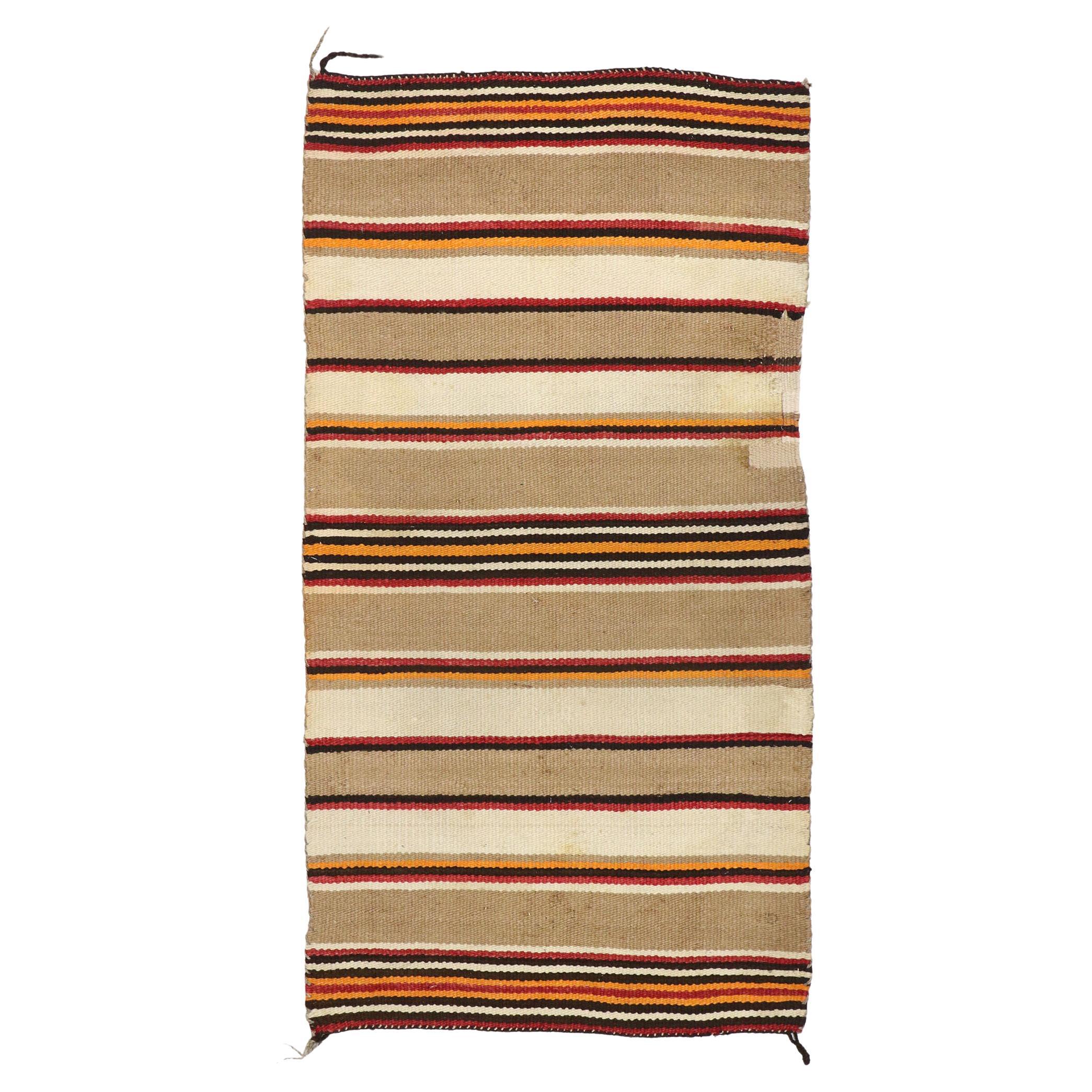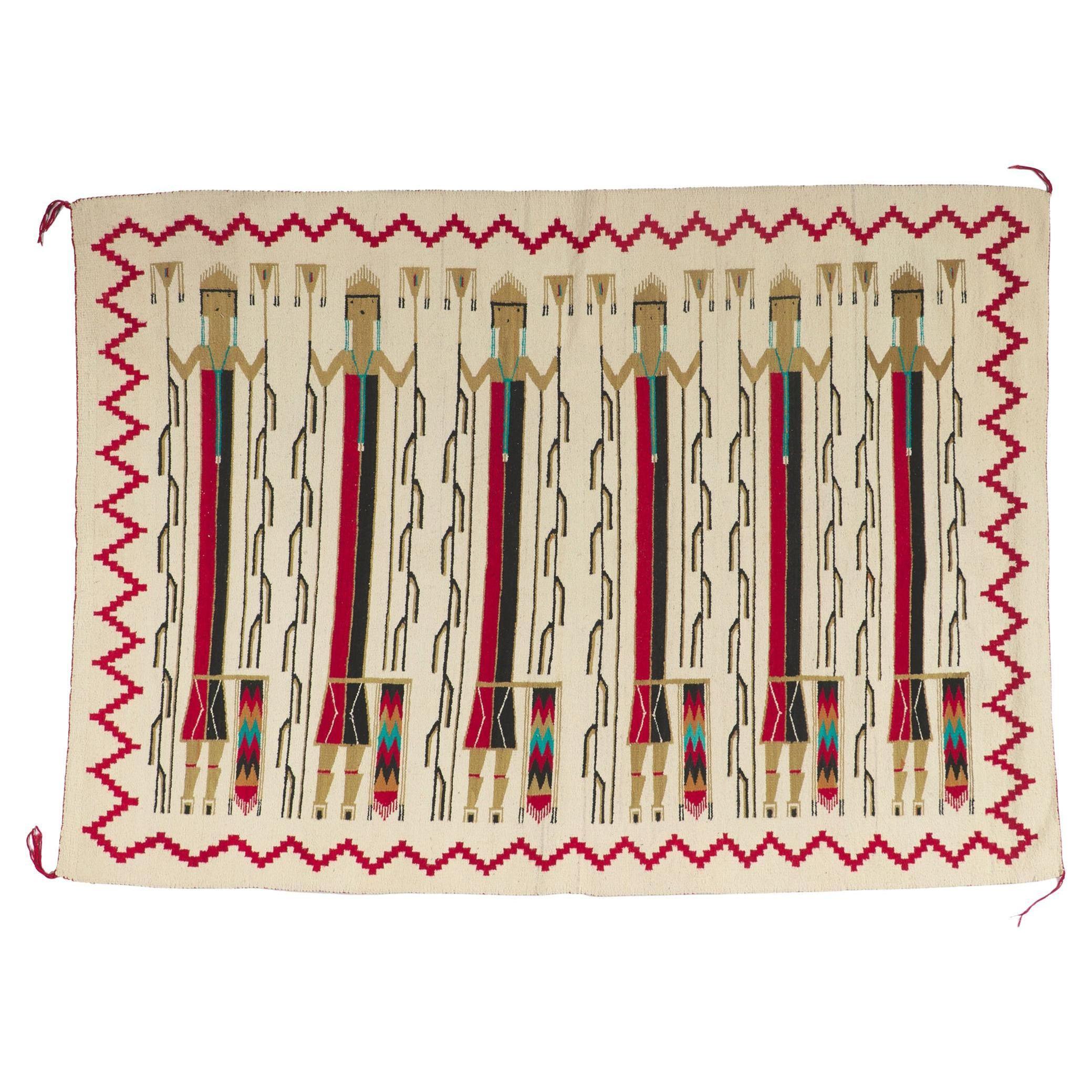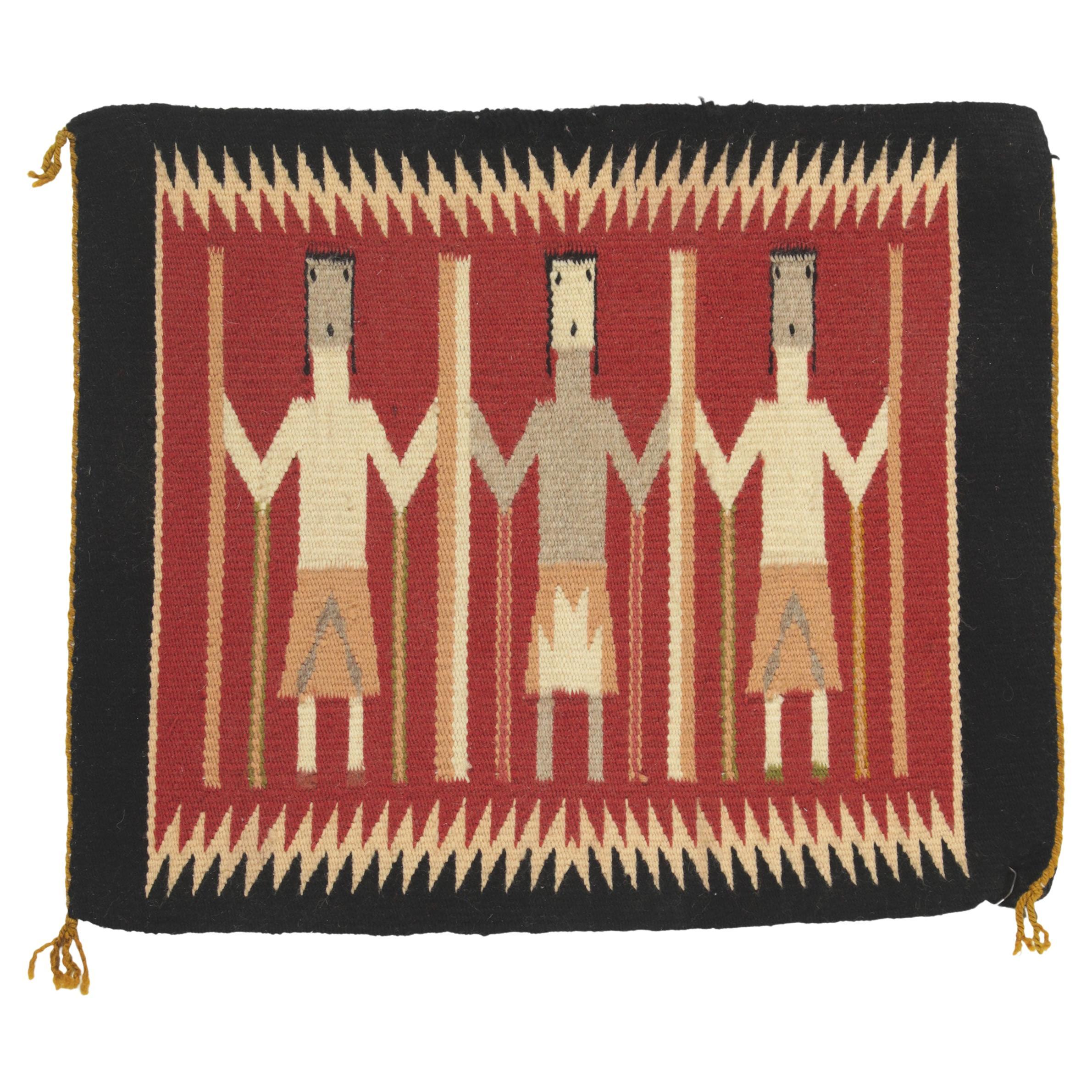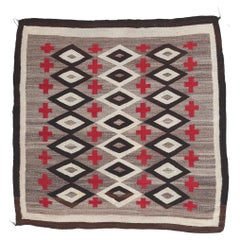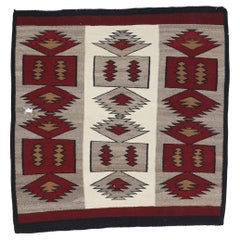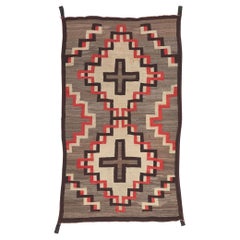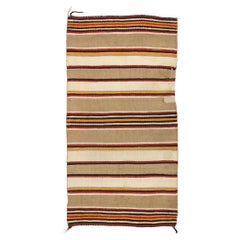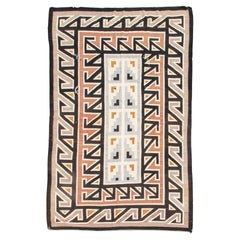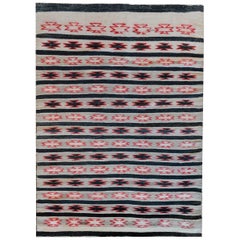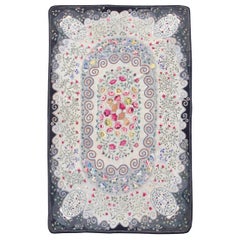Items Similar to 1920's Antique Southwestern-Style Chinle Kilim Rug Early 20th Century
Want more images or videos?
Request additional images or videos from the seller
1 of 11
1920's Antique Southwestern-Style Chinle Kilim Rug Early 20th Century
About the Item
78558 Antique Chinle Southwestern-Style Kilim Rug, 02'09 x 04'06. Bathed in the still breath of the high desert, this handwoven wool antique Southwestern-style textile from the Chinle region emerges as a lyrical meditation on balance, rhythm, and earthborn light. It is a composition not of central medallions or pictorial drama, but of cadence—measured and deliberate—drawn from the enduring tradition of horizontal banded weavings. Rooted in the weaving revival that flourished in the Chinle Valley of northeastern Arizona during the early decades of the 20th century, this textile exemplifies the return to elegant restraint. The artisan—likely shaped by intergenerational teaching and the evolving preferences of regional trading posts—brought together natural hues in layered sequences that reflect the desert’s tonal poetry, from canyon wall to cloud-shadowed mesa.
The field flows in structured repetition, composed of alternating bands in hues of red, camel, ivory, and dusk-toned black. These colors, whether drawn from vegetal sources or early commercial dyes, speak the palette of a land just touched by rain—saturated, grounded, and deeply resonant. Stepped zigzag motifs traverse the composition with rhythmic force, arrow-like in their arrangement and suggestive of elemental energies. These forms, rooted in Indigenous design vocabulary, may reference lightning, paths of spiritual transit, or the meandering flow of water through canyon and arroyo. Far from mere ornament, they are expressions of vitality, movement, and reverence for nature’s dynamic balance.
Throughout the composition, symmetry is maintained not through mirrored shapes, but through balanced intention. The interplay of dark and light, motion and stillness, evokes a deeper harmony—one that echoes philosophical principles of beauty, order, and relationship with the land. Narrow pinstriped bands in muted indigo and umber—woven with restraint and care—act as quiet bridges between broader fields, much like transitional elements in ceremonial life. These delicate bands recall distant rainfall or the fleeting shadows of clouds sweeping across open desert expanses.
This early 20th-century Chinle-area weaving is more than a historical artifact—it is a woven expression of memory, landscape, and cultural continuity. Its banded form reflects an intentional sense of openness and timelessness, as if the horizon it evokes refuses to be contained. In its geometry lies a contemplative order; in its cadence, the echo of voice and ceremony. Woven during a time of cultural resilience and adaptation, this textile stands as a testament to the enduring creative spirit of the Southwest and the landscape from which such art is born.
Rendered in variegated shades of tan, red, black, beige and gray with other accent colors.
Desirable Age Wear. Abrash.
Handwoven wool.
Made in America.
Measures: 02'09 x 04'6.
Date: 1920's. Early 20th Century.
- Creator:Navajo (Weaver)
- Dimensions:Width: 33 in (83.82 cm)Length: 54 in (137.16 cm)
- Style:Spanish Colonial (In the Style Of)
- Materials and Techniques:Wool,Hand-Woven
- Place of Origin:
- Period:
- Date of Manufacture:1920-1929
- Condition:Wear consistent with age and use. Abrash. Desirable Age Wear.
- Seller Location:Dallas, TX
- Reference Number:Seller: 78558 Antique Southwestern-Style Kilim Rug, 02'09 x 04'061stDibs: LU942935165422
About the Seller
4.9
Platinum Seller
Premium sellers with a 4.7+ rating and 24-hour response times
Established in 1995
1stDibs seller since 2012
1,954 sales on 1stDibs
Typical response time: <1 hour
- ShippingRetrieving quote...Shipping from: Dallas, TX
- Return Policy
Authenticity Guarantee
In the unlikely event there’s an issue with an item’s authenticity, contact us within 1 year for a full refund. DetailsMoney-Back Guarantee
If your item is not as described, is damaged in transit, or does not arrive, contact us within 7 days for a full refund. Details24-Hour Cancellation
You have a 24-hour grace period in which to reconsider your purchase, with no questions asked.Vetted Professional Sellers
Our world-class sellers must adhere to strict standards for service and quality, maintaining the integrity of our listings.Price-Match Guarantee
If you find that a seller listed the same item for a lower price elsewhere, we’ll match it.Trusted Global Delivery
Our best-in-class carrier network provides specialized shipping options worldwide, including custom delivery.More From This Seller
View All1920's Antique Southwestern-Style Kilim Rug Ganado Tradition Early 20th Century
By Navajo
Located in Dallas, TX
78559 Antique Ganado Southwestern-Style Kilim Rug, 05'01 x 05'00. Woven beneath the wide skies of the American Southwest, this handwoven wool antique textile from the Ganado regional...
Category
Early 20th Century American Spanish Colonial North and South American Rugs
Materials
Wool
$5,040 Sale Price
25% Off
1920's Antique Southwestern-Style Kilim Rug Early 20th Century
Located in Dallas, TX
78134 Antique Teec Nos Pos Southwestern-Style Kilim Rug, 03'03 x 03'03. Woven in the symbolic shadowlands where red mesas meet turquoise skies, this antique Teec Nos Pos Navajo-style...
Category
Early 20th Century American Spanish Colonial North and South American Rugs
Materials
Wool
$2,799 Sale Price
20% Off
1910's Antique Klagetoh-Inspired Southwestern-Style Kilim Rug Early 20th Century
By Navajo
Located in Dallas, TX
78563 Antique Southwestern-Style Klagetoh Kilim Rug, 05'06 x 09'03. Woven beneath the ancestral skies of the Four Corners region, this handwoven wool antique Southwestern textile in ...
Category
Early 20th Century American Spanish Colonial North and South American Rugs
Materials
Wool
$10,500 Sale Price
25% Off
1920's Antique Southwestern-Style Chinle Kilim Carpet
Located in Dallas, TX
77846 Antique Southwestern-Style Chinle Rug, 02'07 x 04'11. Woven with intention beneath the boundless skies of the American Southwest, this antique wool kilim expresses the quiet rh...
Category
Early 20th Century American Spanish Colonial North and South American Rugs
Materials
Wool
$2,239 Sale Price
30% Off
Antique Southwestern-Style Yeibichai-Figure Kilim Rug Early 20th Century
By Navajo
Located in Dallas, TX
78502 Antique Southwestern-Style Yeibichai-Figure Kilim Rug, 05'03 x 07'03. Woven with reverent artistry and deep cultural resonance, this antique handwoven wool kilim presents a str...
Category
Early 20th Century American Aesthetic Movement North and South American ...
Materials
Wool
$4,880 Sale Price
29% Off
Antique Southwestern-Style Yeibichai-Figure Kilim Rug – Early 20th Century
Located in Dallas, TX
78426 Antique Southwestern-Style Kilim Yeibichai Rug, 01'06 x 01'10. Woven with reverence and symbolic intention, this antique handwoven wool kilim rug captures the spiritual cadence...
Category
Early 20th Century American Spanish Colonial North and South American Rugs
Materials
Wool
$2,128 Sale Price
31% Off
You May Also Like
Antique Teec Nos Pos Navajo Rug, Early 20th Century
Located in San Francisco, CA
Antique Teec Nos Pos Navajo Rug, Early 20th Century
Teec Nos Pos is a small community in Apache County, Arizona. The community is located six miles southeast...
Category
Early 20th Century American North and South American Rugs
Materials
Wool
MId-20th Century Navajo Rug
Located in Chicago, IL
A wonderful mid-20th century Navajo rug with a bands of stars or stylized flowers alternating in crimson and black across the field.
Category
Vintage 1950s American Navajo North and South American Rugs
Materials
Wool
Rustic Southwestern Style North American Navajo Tribal Throw Rug, circa 1920
Located in New York, NY
An antique North American Navajo tribal flat-weave throw rug in the rustic southwestern style handmade during the early 20th century.
Measures: 2' 11" x 4' 3".
Category
Early 20th Century American Rustic North and South American Rugs
Materials
Wool
American Hooked Rug, 20th Century
Located in San Francisco, CA
Large Gray Floral American Hooked Rug, 20th Century
Additional information:
Dimensions: 9'6" W x 14'9" L
Origin: North America
Period: 20th Century (2nd Quarter)
Rug ID: 16940
Category
20th Century American North and South American Rugs
Materials
Wool
American Indian Southwestern Style Wool Rug, 20th Century
Located in Big Flats, NY
An American Southwestern style rug offers wool construction with central medallion and geometric elements, 20th century.
Measures - 49.5" x 30...
Category
20th Century North and South American Rugs
Materials
Wool
$960 Sale Price
20% Off
Mid-20th Century Handmade American Rag Rug
Located in New York, NY
A vintage American rag rug handmade during the mid-20th century.
Measures: 3' 6" x 5' 8"
North American rugs & carpets:
North American has never developed a unified handmade rug tradition, but rather it is the unassimilated confluence of several. From Mexico comes the Saltillo serape wearing blanket, and this stimulates the Navajo and Rio Grande (Colorado) weavers, first as blankets, then as rugs. The thrifty habits of rural America gave rise to the New England (and Western Canadian) hooked rug types, while the farmers of the Midwest recycled their disused garments into braided and rag rugs.
The closest to a real ongoing tradition are the Southwestern (New Mexican) Navajo rugs. By the 1860s the native tribes were weaving wearing blankets with wool from the Spanish churro sheep. These were in stripe design, with combinations of undyed wool with cochineal reds and indigo blues. The multi-phase “Chief’s Blankets” from the 1870s-80s are a natural outgrowth of these. Machine spun red wool from Germantown in Pennsylvania appeared in the 1870s with a bright red hitherto unobtainable. The weavers loved it and blankets appeared with bright reds, generally aniline, in “eye dazzler” patterns. Anglo traders established posts beginning in the 1890s. Navajo weavings were perfect accompaniments not only for Western-themed decors, but for East Coast apartments, only they needed to be thicker and more rug like to be truly accepted. The traders brought Caucasian and Turkish village rugs to copy, borders were introduced and central medallions devised. The weavers continued to create on vertical looms, with a shared warp (dovetailing) weft structure to avoid slits. The warps were cotton string. Sizes were generally scatters, but occasionally a special order came in, hence antique room size Navajos are very rare and very pricey. Distinct village/pueblo styles developed. Among the best are: Two Grey Hills (considered the tightest, closest of all Navajo weaving), Crystal Springs, and Ganado. Certain new patterns such as the “Storm pattern” with jagged lightning bolts emanating from a dark cloud developed. The Yei rug with dancing Kachina doll figures became popular. The palette has been expanded beyond the classic grey, tan, dark brown, and cream natural wool combination to again include reds, blues, and greens. Navajo pictorials include American flags, trains, and automobiles, domestic and local scenes and scenery. Individual artist weavers now command gallery shows and correspondingly elevated prices. There are several levels of Navajo work, and antique and vintage scatters with simple flat designs, medium weaves, and tritonal palettes, and in good floor worthy condition are still available reasonably.
The Native American weaving tradition extends into Colorado with two-piece scatters with sharp sawtooth medallions and striped end borders, with wool tapestry weave on cotton warps. These descend from the Saltillo blankets...
Category
Mid-20th Century American Folk Art North and South American Rugs
Materials
Wool, Cotton, Yarn
Recently Viewed
View AllMore Ways To Browse
Manastir Kilim
Manner Of Fornasetti
Maple Partners Desk
Maralunga 3 Seater Sofa
Marble Gay
Marble Pool Table
Marble Side Table By Joseph Vila Capdevila
Marc Petit
Marcel Breuer Cesca Bar Chair
Marcel Breuer Cesca Chair Circa 1980
Marcuso Coffee Table
Maria Callas Photography
Marigold Sofa
Mario Bellini Break 401
Mario Bellini Le Stelle
Mario Bellini Tentazione Sofa
Mario Grassi
Marion Dorn

